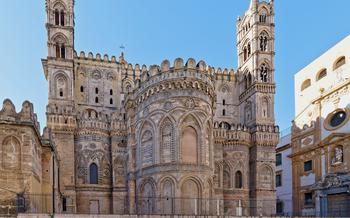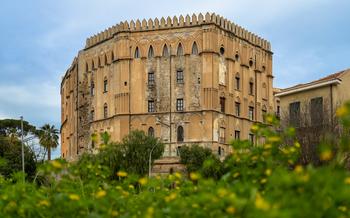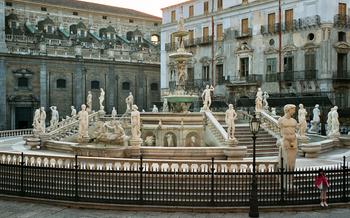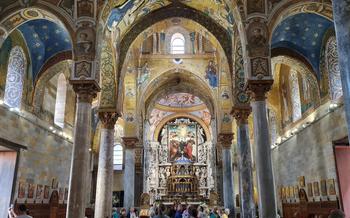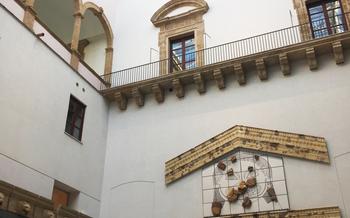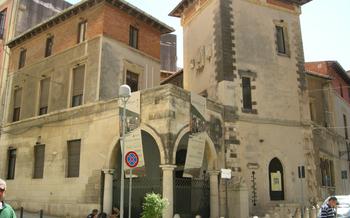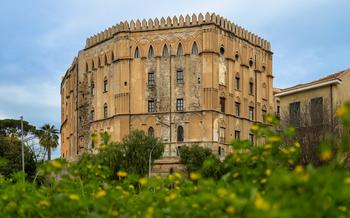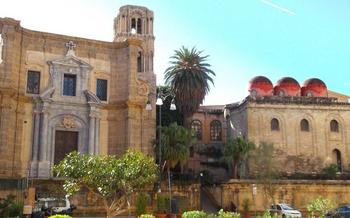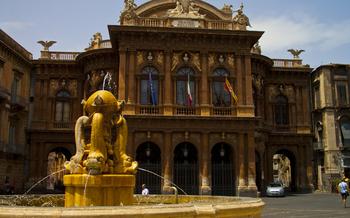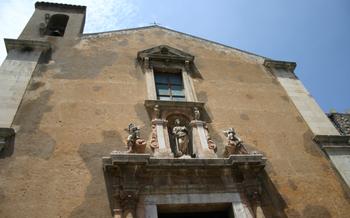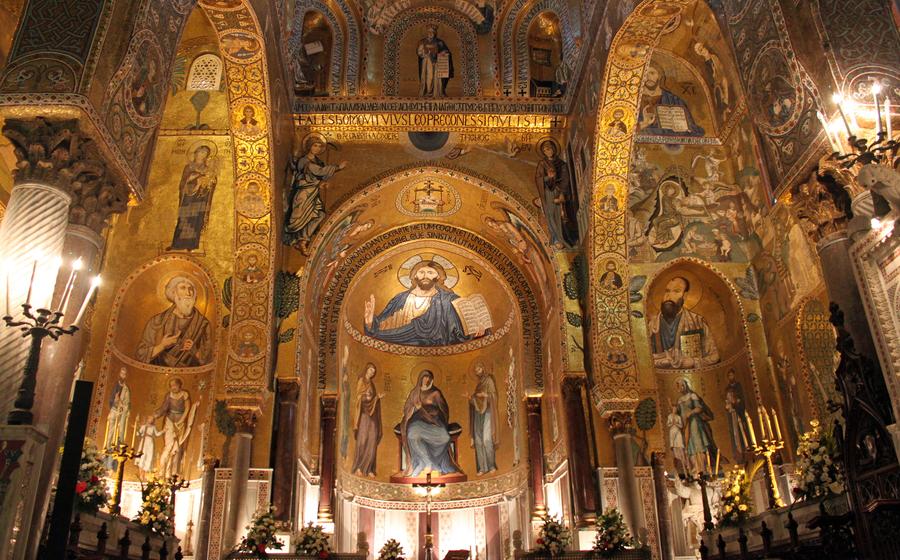
Cappella Palatina
- Introduction - The Allure of Cappella Palatina
- Location and Getting There:
- Historical Background
- Architectural Marvel
- Awe-Inspiring Mosaics:
- Roger II's Throne:
- Hall of Kings
- Cappella della Regina: A Royal Sanctuary
- The Altar and Apse:
- The Treasury
- Rooftop Terrace - Panoramic Views and Tranquility
- Guided Tours
- Tips for Photographers:
- Accessibility and Facilities
- Insider Tip - Secret Passageway
Introduction - The Allure of Cappella Palatina
Nestled within the majestic Norman Palace of Palermo, Sicily, lies a hidden gem that transports visitors back to a time of grandeur and splendor. The Cappella Palatina, with its opulent mosaics, regal architecture, and profound historical significance, offers an unparalleled experience that captivates the hearts and minds of travelers from around the world.
Journey through the annals of time to discover the fascinating history behind the Cappella Palatina, a testament to the vision and power of Roger II, the illustrious Norman king who commissioned its construction in the 12th century. Delve into the rich symbolism and profound messages conveyed through the chapel's exquisite mosaics, masterpieces that showcase the fusion of Byzantine and Islamic art.
Prepare to be awestruck by the Cappella Palatina's enduring legacy as a symbol of royal authority and a testament to the Norman dynasty's reign over Sicily. Step into a world where art, history, and spirituality converge, creating an unforgettable journey that will leave you spellbound.
Location and Getting There:
The Cappella Palatina is conveniently located within the Norman Palace in the heart of Palermo, Italy. The palace itself is situated on Piazza Indipendenza, a central square easily accessible by foot or public transportation.
Getting there:
-
On foot: Many visitors choose to explore the historic center of Palermo on foot, as it is a walkable city. From the city center, it is a short and pleasant walk to the Norman Palace.
-
Public transportation: For those who prefer to use public transportation, there are several bus lines that stop near the Norman Palace. The closest bus stop is "Palazzo Reale/Cattedrale," served by lines 101, 102, and 10
Nearby must-see sites:
-
Cathedral of Palermo: Located just steps away from the Norman Palace, the Cathedral of Palermo is another architectural masterpiece that should not be missed.
-
Piazza Pretoria: A beautiful square adorned with a monumental fountain, Piazza Pretoria is a popular spot for locals and tourists alike.
-
Ballarò Market: Immerse yourself in the vibrant atmosphere of Palermo's oldest market, Ballarò Market, where you can find fresh produce, local delicacies, and traditional crafts.
-
Opening hours: The Cappella Palatina is generally open to the public from 8:30 AM to 6:00 PM, Tuesday to Sunday. It is closed on Mondays.
-
Admission fees: The entrance fee for the Cappella Palatina is 10 euros for adults, 5 euros for students, and free for children under 1
Historical Background
The Cappella Palatina stands as a testament to the remarkable Norman conquest of Sicily and the reign of Roger II. In the 11th century, the Normans, led by Roger I, invaded and conquered Sicily from the Arabs. Roger II, the son of Roger I, ascended to the throne in 1130 and embarked on an ambitious campaign to consolidate his power and establish a magnificent kingdom. The Cappella Palatina was one of his grandest projects, reflecting his desire to create a symbol of his authority and celebrate his reign.
Roger II envisioned the chapel as a showcase of his power and wealth, a place where he could hold court, receive foreign dignitaries, and demonstrate his devotion to Christianity. He spared no expense in its construction, employing the finest craftsmen and artists from across his realm. The result was a breathtaking masterpiece that blended elements from various cultures, showcasing the unique fusion of Byzantine, Islamic, and Western influences that characterized the Norman kingdom of Sicily.
Architectural Marvel
The Cappella Palatina stands as a testament to the fusion of architectural styles that characterized the Norman period in Sicily. Its design blends elements of Byzantine, Islamic, and Norman architecture, creating a harmonious and visually stunning masterpiece.
The chapel's most striking feature is its majestic dome, which dominates the interior space. Supported by four massive pillars, the dome is adorned with intricate mosaics depicting scenes from the Bible. The combination of the dome's soaring height and the vibrant colors of the mosaics creates a sense of awe and wonder that is truly breathtaking.
The Cappella Palatina is also renowned for its intricate carvings and sculptures. The walls and columns are adorned with a profusion of detailed reliefs, depicting a variety of religious and secular subjects. These sculptures range from biblical scenes to images of animals, mythical creatures, and historical figures. The craftsmanship displayed in these carvings is truly remarkable, and they contribute to the chapel's overall grandeur.
The Cappella Palatina truly embodies the harmonious fusion of eastern and western elements that characterized the Norman period in Sicily. Its unique blend of architectural styles, exquisite mosaics, and intricate carvings make it a masterpiece of medieval architecture that continues to inspire and captivate visitors to this day.
Awe-Inspiring Mosaics:
The Cappella Palatina is renowned for its breathtaking mosaics that adorn the walls, ceilings, and altar. These exquisite artworks depict biblical scenes, religious figures, and historical events, offering a visual feast for visitors. The vibrant colors and intricate craftsmanship create a sense of awe and wonder, immersing visitors in a world of faith and devotion.
The mosaics narrate stories from the Old and New Testaments, depicting the creation of the world, the lives of the patriarchs, and the teachings of Jesus Christ. The artists employed a variety of techniques, including tessellation, to create lifelike figures and scenes that seem to come alive before the viewer's eyes.
One of the most striking mosaics is the depiction of Christ Pantocrator, the all-powerful ruler of the universe, which dominates the apse of the chapel. Christ is portrayed with a stern expression, surrounded by a celestial court of angels and saints. The mosaic's golden background and radiant colors evoke a sense of divine majesty and power.
The mosaics not only convey religious messages but also serve as a testament to the political and cultural significance of the Norman Kingdom of Sicily. They glorify the reign of Roger II, portraying him as a wise and just ruler, and celebrate the fusion of Eastern and Western artistic traditions that characterized the Norman court.
Roger II's Throne:
In the heart of the Cappella Palatina, a majestic throne awaits visitors, embodying the power and grandeur of Roger II, the Norman king. Carved from a single block of ivory, this throne stands as a testament to Roger II's grand vision and his commitment to establishing a strong and prosperous kingdom. Intricate carvings adorn the throne, showcasing a captivating blend of Islamic and classical motifs. The throne represents not only Roger II's authority but also the cultural diversity and artistic prowess that flourished during his reign.
Hall of Kings
Adjacent to the Cappella Palatina, the Hall of Kings is an awe-inspiring gallery adorned with a series of majestic mosaics depicting the powerful rulers of the Norman dynasty. Each mosaic, a masterpiece of intricate craftsmanship and vibrant colors, narrates the story of a different king, capturing their conquests, diplomatic achievements, and displays of authority.
These mosaics, arranged in chronological order, offer a visual chronicle of the Norman dynasty's rise to power in Sicily. From the stern countenance of Roger I, the founder of the dynasty, to the regal bearing of William II, the last Norman king, each mosaic provides a glimpse into the personalities and reigns of these influential monarchs.
The stories depicted in these mosaics go beyond mere historical accounts; they are testaments to the political prowess, military might, and cultural legacy of the Norman rulers. Explore the tales of their conquests, their alliances, and their contributions to the development of Sicily. Marvel at the intricate details, the lifelike expressions, and the vibrant colors that bring these historical figures to life.
The Hall of Kings is not just a gallery of portraits; it is a visual narrative of a dynasty that shaped the course of Sicilian history. Through these mosaics, visitors can gain a deeper understanding of the Norman era and its lasting impact on the island's culture, politics, and society.
Cappella della Regina: A Royal Sanctuary
Adjacent to the Cappella Palatina lies the Cappella della Regina, a smaller yet equally stunning chapel. Constructed specifically for the use of the queen and her court, this chapel exudes an air of regal elegance and devotion. Step into this sacred space and be captivated by the exquisite mosaics that adorn its walls and ceiling.
The Cappella della Regina is a testament to the power and influence of the Norman queens, particularly Eleanor of Aquitaine, who played a pivotal role in shaping the cultural and political landscape of Sicily. Discover the intriguing story of Eleanor, a woman of remarkable intelligence and ambition, who left an indelible mark on the history of the island.
The Altar and Apse:
The centerpiece of the Cappella Palatina is undoubtedly the altar and apse, a breathtaking ensemble of mosaics that command awe and contemplation. Above the altar, the majestic figure of Christ Pantocrator, the Almighty, reigns supreme, his piercing gaze and raised hand instilling a sense of reverence. Surrounded by a celestial court of angels and saints, Christ embodies the divine presence, blessing and protecting the realm.
The apse, the semi-circular area behind the altar, is adorned with an intricate mosaic that depicts the heavenly court, where the Virgin Mary, flanked by archangels and saints, intercedes for humanity before the throne of God. Every detail in the mosaic holds symbolic meaning, from the gestures and expressions of the figures to the vibrant colors and intricate patterns.
The altar and apse, with their exquisite craftsmanship and profound symbolism, represent the culmination of artistic achievement in the Cappella Palatina. They offer a glimpse into the spiritual beliefs and aspirations of the Norman rulers, who sought to create a sacred space that would reflect their power and devotion.
The Treasury
Concealed within the sacred confines of the Cappella Palatina lies a treasure trove of exquisite artifacts that narrate the opulent wealth and pious devotion of the Norman court. These precious objects, meticulously crafted by skilled artisans and adorned with gleaming gold, precious stones, and intricate enamel work, were generously donated by Roger II and his successors as offerings to the divine.
Among the resplendent collection, visitors can marvel at intricately crafted goldwork, shimmering jewels, and sacred religious relics that evoke a sense of awe and wonder. These treasures, imbued with historical significance, provide a glimpse into the lavish lifestyle and deep-rooted faith that characterized the Norman era.
The Treasury stands as a testament to the grandeur and opulence of the Norman court, showcasing the exceptional craftsmanship and artistic mastery that flourished during their reign. Every artifact whispers tales of devotion, power, and the enduring legacy of the Norman kings who once graced the halls of the Cappella Palatina.
Rooftop Terrace - Panoramic Views and Tranquility
Ascend to the rooftop terrace of the Cappella Palatina to witness panoramic vistas that will leave you breathless. The city of Palermo unveils its architectural tapestry before your eyes, with iconic landmarks like the Teatro Massimo and the domes of other historic churches dotting the skyline. Immerse yourself in the tranquility and serenity of the terrace, a hidden gem that offers respite from the vibrant city below. Capture breathtaking photographs of the cityscape, with the majestic Cappella Palatina serving as a stunning backdrop. This elevated perspective provides a unique opportunity to appreciate the grandeur and beauty of Palermo from above.
Guided Tours
Embark on a journey of discovery with a knowledgeable guide who will illuminate the intricacies of the Cappella Palatina. Listen to captivating tales that bring the mosaics to life, unveiling the stories, symbolism, and significance of each masterpiece. Immerse yourself in the history of the chapel, learning about its construction, its role in the Norman court, and its enduring legacy. With an expert guide, you'll gain a deeper understanding of the chapel's architecture, art, and iconography, ensuring a truly enriching and memorable experience.
Avoid the crowds and gain personalized attention by booking a private tour. Your guide will tailor the tour to your interests, ensuring you make the most of your visit. Private tours offer a unique opportunity to ask questions, delve into specific details, and receive undivided attention from your guide. Whether you're an art enthusiast, a history buff, or simply seeking a deeper connection to the Cappella Palatina, a guided tour is an invaluable investment.
Tips for Photographers:
For photographers eager to capture the stunning beauty of the Cappella Palatina, careful planning and preparation are essential. The best time to visit for optimal lighting is during the morning hours, when the sunlight streams through the windows, illuminating the mosaics with a warm glow. Tripod use is highly recommended to ensure sharp images, especially in the dimmer corners of the chapel. To avoid reflections and glare, consider using a polarizing filter or shooting at an angle to the mosaics. For dramatic and artistic shots, experiment with different perspectives, such as capturing the mosaics from below or using a wide-angle lens to exaggerate the grandeur of the space. Remember to respect the sanctity of the chapel and be mindful of other visitors while pursuing your photographic endeavors.
Accessibility and Facilities
The Cappella Palatina is committed to providing an inclusive and accessible experience for all visitors. Wheelchair users and individuals with limited mobility can easily navigate the chapel's main level, which features wide doorways and ramps. Accessible restrooms are available within the premises, ensuring convenience and comfort for all.
For families with young children, the chapel offers a range of amenities to enhance their visit. Strollers can be accommodated within the chapel, allowing parents to maneuver comfortably. Family-friendly tours are also available, providing engaging and age-appropriate content that keeps children entertained while they learn.
The Cappella Palatina recognizes the importance of preserving its rich history while embracing modern conveniences. Visitors can take advantage of the on-site gift shop, which offers a curated selection of souvenirs, books, and postcards. These mementos serve as lasting reminders of the chapel's splendor.
For those seeking a break from their exploration, a charming café is located within the premises, providing a delightful respite to savor a refreshing beverage or a light snack. Whether you're seeking refreshments or a place to rest your feet, the café offers a welcoming ambiance to enhance your visit.
To ensure a seamless experience, the Cappella Palatina provides secure facilities for storing luggage and personal belongings, allowing visitors to explore the chapel's wonders without the burden of carrying their belongings. With these thoughtful amenities, the Cappella Palatina caters to the needs of all visitors, creating a welcoming and inclusive environment for everyone to enjoy.
Insider Tip - Secret Passageway
Delve into the intriguing history of the Cappella Palatina by uncovering a hidden passageway that leads to the magnificent Royal Palace. This secret route, once used by royalty and their entourage, offers a unique perspective of the palace and its opulent grandeur. As you traverse the passageway, imagine the footsteps of powerful monarchs and their trusted advisors echoing through the centuries.
Emerging into the Royal Palace, you will find yourself surrounded by stunning architecture, intricate tapestries, and priceless works of art. Explore the grand halls and chambers, each with its own captivating story to tell. Immerse yourself in the rich history of the Norman kings and queens who once ruled over this magnificent kingdom.
Don't miss this opportunity to experience the Cappella Palatina and the Royal Palace in a truly unforgettable way. Discover the secrets of the past and create lasting memories that will transport you back to a time of power, intrigue, and splendor.
